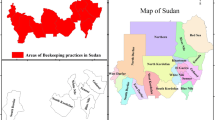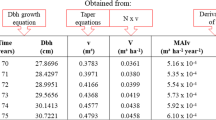Abstract
Pine honeydew honey is an economically important non-wood forest product from eastern Mediterranean Pinus brutia forests, which are also important for timber production. Pine honey is produced by bees that feed on the honeydew secretions of Marchalina hellenica, a scale insect that infests pine stands and feeds on pine sap. The aim of this study was to optimize the joint production of pine honeydew honey and timber by maximizing the soil expectation value of pine stands. The simulation of P. brutia stand dynamics and timber production in healthy and infested stands is based on individual-tree growth and yield models that account for the effect of M. hellenica on tree- and stand-level growth and mortality. The optimization procedure uses a direct search method based on nonlinear programming. The results suggest that pine stands growing on good sites should be managed using rather short rotations and mainly aiming at timber production. In contrast, forest management in medium- and poor-quality sites should aim at longer rotations by taking advantage of the joint production of pine honey and timber assortments. Honey-oriented forest management can be much more profitable than timber production in stands growing on medium and poor sites. Pine honey represents an opportunity to increase the value and economic profitability of P. brutia forests.



Similar content being viewed by others
References
Auclair JL (1963) Aphid feeding and nutrition. Annu Rev Entomol 8:439–490
Bacandritsos N (2004) Establishment and honeydew honey production of Marchalina hellenica (Coccoidea Margarodidae) on fir tree (Abies cephalonica). Bull Insectol 57(2):127–130
Bacandritsos N, Saitanis C, Papanastasiou I (2004) Morphology and life cycle of Marchalina hellenica (Gennadius) (Hemiptera: Margarodidae) on pine (Parnis Mt.) and fir (Helmos Mt.) forests of Greece. Ann Soc Entomol Fr 40(2):169–176
Bettinger P, Siry J, Cieszewski C, Merry KL, Zengin H, Yeşil A (2013) Forest management issues of the southern United States and comparisons with Turkey. Turkish J Agric For 37:83–96
Bonneh O (2000) Management of planted pine forests in Israel: past, present and future. In: Ne’eman G, Trabaud L (eds) Ecology, biogeography and management of Pinus halepensis and P. brutia forest ecosystems in the Mediterranean basin. Buckhuys Publishers, Leiden, pp 377–390
Boydak M (2004) Silvicultural characteristics and natural regeneration of Pinus brutia Ten.—a review. Plant Ecol 171:153–163
Boydak M, Dirik H, Çalıkoğlu M (2006) Biology and silviculture of Turkish red pine (Pinus brutia Ten.). Ormancılığı Geliştirme ve Orman Yangınları ile Mücadele Hizmetlerini Destekleme Vakfı Yayını, Lazer Ofset Matbaası, Ankara, Turkey
Buckley R (1987) Interactions involving plants, Homoptera, and ants. Annu Rev Ecol Syst 18:111–135
Calish S, Fight RD, Teeguarden DE (1978) How do nontimber values affect Douglas-fir rotations? J For 76:217–221
Croitoru L, Liagre L (2013) Contribution of forests to a green economy in the Middle East and North Africa: evidence, drivers and policy orientations. GIZ, Silva Mediterranea and Collaborative Partnership on Mediterranean Forests, p 30
de-Miguel S, Pukkala T, Shater Z, Assaf N, Kraid B, Palahí M (2010) Models for simulating the development of even-aged Pinus brutia stands in Middle East. For Syst 19:449–457
de-Miguel S, Mehtätalo L, Shater Z, Kraid B, Pukkala T (2012a) Evaluating marginal and conditional predictions of taper models in the absence of calibration data. Can J For Res 42(7):1383–1394
de-Miguel S, Pukkala T, Assaf N, Bonet JA (2012b) Even-aged or uneven-aged modelling approach? A case for Pinus brutia. Ann For Sci 69(4):455–465
de-Miguel S, Pukkala T, Assaf N, Shater Z (2014) Intra-specific differences in allometric equations for aboveground biomass of eastern Mediterranean Pinus brutia. Ann For Sci 71(1):101–112
EPPO (2008) Marchalina hellenica. Alert List. Internet: http://www.eppo.int/QUARANTINE/Alert_List/deleted%20files/insects/Marchalina_hellenica.doc. Accessed July 2013
FAO (2010) Global forest resources assessment 2010—main report. FAO Forestry Paper No. 163. Rome, p 340
Gallis AT (2007) Evaluation of the damage by the insect Marchalina hellenica (Genn.) in Eastern Attica, Greece. Conclusions for sustainable management of forest ecosystems. In: Proceedings of the 10th International Conference on Environmental Science and Technology, Kos Island, Greece 5th–7th September 2007, pp 191–196
Gounari S (2004) Seasonal development and ovipositing behaviour of Marchalina hellenica (Hemiptera: Margarodidae). Entomologia hellenica 15:27–38
Gounari S (2006) Studies on the phenology of Marchalina hellenica (gen.) (Hemiptera: Coccoidea, Margarodidae) in relation to honeydew flow. J Apic Res 45(1):8–12
Hartman R (1976) The harvesting decision when a standing forest has value. Econ Inq 14(1):52–58
Hatjina F, Bouga M (2009) Portrait of Marchalina hellenica Gennadius (Hemiptera: Margarodidae), the main producing insect of pine honeydew—biology, genetic variability and honey production. Bee Sci 9(4):162–167
Hooke R, Jeeves TA (1961) “Direct search” solution of numerical and statistical problems. J Assoc Comput Mach 8:212–229
James A, Dungan R, Plank M, Ito R (2007) A dynamical model of honeydew droplet production by sooty-beech scale insects (Ultracoelostoma spp.) in New Zealand Nothofagus forest. Ecol Model 209:323–332
Karanikola P, Tsikas A (2012) The most important forest insects of Greece and their management. In: Katsifarakis KL, Theodossiou N, Christodoulatos C, Koutsospyros A, Mallios Z (eds) Proceedings of the International Conference on protection and restoration of the environment XI (PRE-11), pp 1070–1076
McKinnon LM, Kayahara GJ, White RG (2006) Biological framework for commercial thinning even-aged single-species stands of jack pine, white spruce, and black spruce in Ontario. Ontario Ministry of Natural Resources, Science and Information Branch, Northeast Science and Information Section, South Porcupine, ON. Technical Report TR-046, p 126
Mendel Z (2000) The phytophagous insect fauna of Pinus halepensis and P. brutia in the Mediterannean. In: Ne’eman G, Trabaud L (eds) Ecology, biogeography and management of Pinus halepensis and P. brutia forest ecosystems in the Mediterranean basin. Backhuys Publishers, Leiden, pp 217–236
Miina J, Pukkala T, Hotanen JP, Salo K (2010) Optimizing the joint production of timber and bilberries. For Ecol Manag 259(10):2065–2071
Nikolopoulos CN (1965) Morphology and biology of the species Marchalina hellenica (Gennadius) (Hemiptera Margarodidae Coelostomidiinae). Ecole de Hautes Etudes Agronomique des Athenes, Laboratoire Zoologie Agronomie et Serie, Athens
Olschewski R, Klein AM, Tscharntke T (2010) Economic trade-offs between carbon sequestration, timber production and crop pollination in tropical forested landscapes. Ecol Complex 7(3):314–319
Öztürk AI, Sahin Z (2008) Economic importance of beekeeping in Muğla. In: Proceedings of first international beekeeping and pine honey congress, Muğla Turkey, pp 64–66
Pak M, Türker MF, Öztürk A (2010) Total economic value of forest resources in Turkey. Afr J Agric Res 5(15):1908–1916
Palahí M, Pukkala T, Bonet JA, Colinas C, Fischer CR, Martínez de Aragón J (2009) Effect of the inclusion of mushroom values on the optimal management of even-aged pine stands of Catalonia. For Sci 55(6):503–511
Pechhacker H (1988) Long-term forecast of Physokermes (Homoptera, Coccidae) honeydew flow on spruce. Apidologie 19:73–84
Petrakis PV, Roussis V, Vagias C, Tsoukatou M (2010) The interaction of pine scale with pines in Attica, Greece. Eur J For Res 129:1047–1056
Petrakis PV, Spanos K, Feest A (2011) Insect biodiversity reduction of pinewoods in southern Greece caused by the pine scale (Marchalina hellenica). For Syst 20(1):27–41
Price C (1989) The theory and application of forest economics. Basil Blackwell, Oxford 402 p
Rackham O (2008) Ancient woodlands: modern threats. New Phytol 180(3):571–586
Saner G, Engindeniz S, Tolon B, Cukur F (2003) The economic analysis of beekeeping enterprise in sustainable development: a case study of Turkey. Apiacta 4:6
Santas LK (1983) Insects producing honeydew exploited by bees in Greece. Apidologie 14(2):93–103
Schimitschek E (1980) Manna. Anzeiger fur Schadlingskunde Pflanzenschutz Umweltschutz. 53(8):113–121
Shater Z, de-Miguel S, Kraid B, Pukkala T, Palahí M (2011) A growth and yield model for even-aged Pinus brutia stands in Syria. Ann For Sci 68:149–157
Ülgentürk S, Kıran K, Civelek HS, Dursun O, Ayhan B, Şahin Ö, Ersen A, Evren N (2011) Ants species (Hymenoptera: Formicidae) associated with Marchalina hellenica Genn. (Hemiptera: Monophlebidae) in Turkey. In: Proceedings of the fourth plant protection congress of turkey, 28th–30th June 2011, Kahramanmaraş, p 222
Vanclay JK (1994) Modelling forest growth and yield: applications to mixed tropical forests. CAB International, UK, p 312
Way MJ (1963) Mutualism between ants and honeydew-producing Homoptera. Annu Rev Entomol 8:307–344
Yeşil A, Gürkan B, Saraçoğlu Ö, Zengin H (2005) Effect of the pest Marchalina hellenica Gennadius (Homoptera, Margarodidae) on the growth parameters of Pinus brutia Ten. in Muğla region (Turkey). Pol J Ecol 53(3):451–458
Author information
Authors and Affiliations
Corresponding author
Additional information
Communicated by M. Moog.
Rights and permissions
About this article
Cite this article
de-Miguel, S., Pukkala, T. & Yeşil, A. Integrating pine honeydew honey production into forest management optimization. Eur J Forest Res 133, 423–432 (2014). https://doi.org/10.1007/s10342-013-0774-2
Received:
Revised:
Accepted:
Published:
Issue Date:
DOI: https://doi.org/10.1007/s10342-013-0774-2




